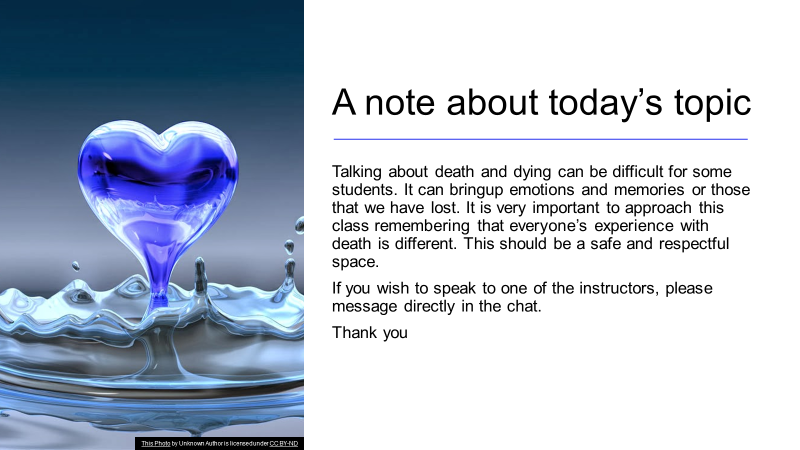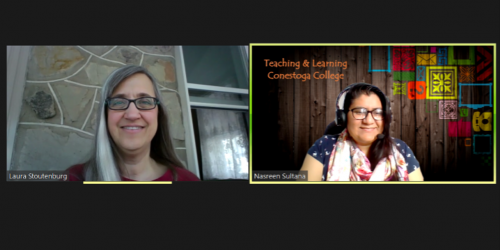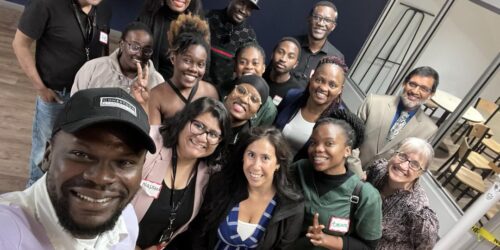Content Warnings in Teaching
Written by Teaching & Learning Consultants Sara Kafashan, Lauren Spring, and Laura Stoutenburg
- Have you ever introduced a topic such as family trends in Canada, alcohol use, ecology, ways of building housing, ethics in policing, or workplace accidents or professionalism and had the conversation get risky?
- Have you ever worried a student might be hurt or confused when a sensitive or potentially personal topic like mental health or disability comes up? That the content you share might bring up difficult feelings or past traumas?
- Have you asked yourself if your ways of introducing such topics and the words and activities you associate with them could help students process this content better?
This teaching tip will give you a heads up on potentially challenging subject areas and share some examples of how faculty across different disciplines provide content warnings to students. It will also provide you with some practical advice by offering suggestions about what to do before, during, and after potentially difficult topics are introduced in class.
What are Content Warnings Anyway, and are They Helpful?
Content warnings, often referred to as trigger warnings, are verbal or written notices made in advance of introducing course content which is potentially sensitive in nature and/or might cause distress to one or more students. Content warnings give students an opportunity to prepare for the learning, and if necessary, engage with student supports, resources, and/or self-care to promote their own well-being.
According to Conestoga’s student rights and responsibilities, “Students have the right to learn and work in an environment that is safe, secure, free from harassment and/or discrimination and be treated with respect and dignity.” But what exactly does it mean for a classroom to be “safe” for learning? Post-secondary classrooms are places where students come to learn about what to expect on the job practically, professionally, and interpersonally. In some programs, students also encounter big questions and complex social conundrums which often lead to passionate and transformative conversations with their faculty and peers.
While there are certain topics faculty might assume to be potentially difficult for students (e.g., sexual assault, war, self-harm/suicide, genocide, human trafficking, police brutality, workplace accidents etc.), it is important to remember that adult learners bring with them lives full of rich and often painful experiences. It is, therefore, impossible for anyone to anticipate each topic that could be emotionally difficult or “to warn against every potentially [distressing] situation” (Boysen & Prieto, 2018; Cebula et al., 2022, p. 2).
This is not an argument, however, against the use of content warnings. Rather, recent research suggests that they serve as “an act of inclusion and empathy towards students; a means of fostering open and authentic discourse between staff and students… (and as) a reminder to non-affected students about the need to discuss topics sensitively” (Cebula et al., 2022, p. 3; Nolan and Roberts 2021).
Below are some practical tips and considerations when applying content warnings to post-secondary teaching.
Examples of Content Warnings
In this section, you will view five examples of content warnings:
The first example showcases a content warning specific to one topic provided by Conestoga faculty, Kathryn Cooper:
This class includes a discussion and videos of the harsh treatment experienced by First Nations children in residential schools. This content is disturbing, so I encourage everyone to prepare themselves emotionally before proceeding. If you believe that listening to this will be traumatizing for you, then you may choose to forgo it. You will still, however, be responsible for material that you miss, so please arrange to get notes from another student or see me individually. – Kathryn Cooper, Truth and Reconciliation Class for CSR & Ethics
The second example shows a content warning specific to a learning module or unit outcome:
“This week we will learn about suicide prevention and intervention (Unit outcomes 10.1 – 10.3). As future human service providers, it is important for us to better understand how we can recognize symptoms of suicidal behaviour and self-harm, in the hopes that we can support our clients in getting the resources they need. In learning about this topic, we will be watching a 5-minute video in class together. This video will depict images and content about depression and suicidal thoughts. You will listen to someone talk about their experience with suicidal thoughts, and their plans to complete suicide by hanging. You will not see images or video of a suicide occurring or any self-harm behaviours.
This content and video may activate high emotionality and/or distressing thoughts. I urge you to emotionally prepare yourself for this class. To do this, you may wish to engage in a supportive self-care practice for yourself before or after (or if appropriate during; e.g., wear a cozy sweatshirt) this class. As we usually do during lessons with high emotionality learnings, I will tell you when we are about to watch the video, and check in after the video. If you need to leave the classroom (or zoom room) during the video, I ask that you give me a thumbs up before you leave (or private chat message me) to indicate that you are well and leaving for other reasons (e.g., use the washroom, getting a drink of water).” – Written by Sara Kafashan
The third example demonstrates a slide shown at the beginning of a module on death and dying in a PSW course on palliative care.

Sarah Givens
The fourth and fifth examples show content warnings specific to an entire course:
“As part of this course we spend time discussing the importance of recognizing and support those with mental health concerns. There are many supports available for students at Conestoga College to help support their mental health and wellbeing. Here is the link to the Wellness Supports through Student Success Services.
- The email address is counselling@conestogac.on.ca
- There is also some additional information and connections listed below. Please reach out if any of these supports could be of support to you.
- Are you ok? Our How to Ask for Help at Conestoga guide was made for you.
- Need to talk to someone right now? Good 2 Talk is a free, confidential 24/7 post-secondary student helpline. Call 1-866-925-5454 or text GOOD2TALKON to 686868.
- Are you experiencing an emergency or mental health crisis? Call 911 for emergency services or Here 24/7 for crisis services at 1-844-437-3247.”
Sarah Givens, for a PSW course on Mental Health
“This course includes discussion of representations of social violence. Before beginning the course, please be mindful of your capacity to witness and respond to videos, books, images, and podcasts that represent violence. If you think you might find the content overwhelming, please speak to your faculty at the start of the course, or at any point in the semester.” – Adapted by Lauren Spring
Establish a safe classroom environment to anticipate possible distress
Based on a study surveying the experience of college and university students, Cebula et al. identify strategies which students have found helpful when sensitive topics arise (2022). Four key strategies involve an overall approach to the class. Each of the strategies are relevant to virtual or in-person classroom settings:
- Create a supportive classroom atmosphere through “setting explicit ground rules, a verbal contract, or drawing up an agreement” (p. 9). These contracts and agreements can be done at the beginning of the semester as a whole-class activity. For example, Conestoga students in nursing, healthcare, and emergency pre-hospital programs engage in “role-play” simulations with live actors about many potentially difficult topics, such as end of life care. Though these learning experiences are very carefully set up and debriefed, one “ground rule” that Karl Weiss and other faculty members have found to be helpful is to have a “quiet room” — an empty classroom in the simulation lab—where students can go if they are feeling upset by the “real-to-life” scenario they experienced. Students can communicate with faculty if they would like to be alone in this room or to have company to talk things through in an environment that is less overwhelming than a full class debrief.
- Provide advance notice of topics to be discussed (p. 10). This can be done through the Instructional Plan, through descriptions of the weekly modules, and/or through weekly announcements .
- Offer choice (p. 10). This can include choice to participate or not in specific classroom activities, choice of questions on exams, choice of materials, and a range of choice within assignments. If you offer the option of a “pass” on a particular activity, establish this at the outset of the course. To offer choice of materials, for example, you may allow students to pick one of three readings (e.g., about eating disorders, domestic violence, or self-harm) to complete an assignment about complex social issues.
Be mindful of examples within course content
Examples and case studies are a great way for students to grapple with course topics and apply their learnings. However, it is important to ensure the examples used in teaching link directly to course or unit learning outcomes and do not cause undue distress, especially when other options for examples/case studies are possible. In choosing examples for teaching, you may want to reflect on the below questions:
- Why are you using this exact example or case study?
- How does the example or case study relate to learning outcomes?
- How does the example or case study support student learning?
- How appropriate are your examples or case studies to your students’ understanding and context?
- What is the balance between the value of using this exact example or case study versus the potential for harm?
Jeff Oakes, Chair of Trades and Apprenticeships at Conestoga, has taken a very thoughtful approach when it comes to sharing examples. He says: “We know trades have inherent dangers and showing pictures of dismembered souls is poor practice in my opinion.” So rather than show examples of what could go wrong or photos that “no one wants to see” he instead takes his students past a toolbox on campus that belonged to a person who died on the shop floor as a mechanic (the family donated it post-accident). Jeff takes his Level 1 students past this person’s tool box during safety orientation and tells his story.
Jeff says: “(Students) do not need to see a picture of the scene, the toolbox speaks loud enough…(it helps) remind everyone about what people are worth and how safe practices are paramount. Most of my students simply stay silent knowing the accident could have been avoided.”
Establish the following student-centered practices
When teaching potentially distressing content, students may feel better supported if:
- They know how and where to access Conestoga student resources (see “Useful Links”)
- They are encouraged to self-regulate and practice self-care
- They understand why and how the content relates to the learning outcomes (e.g., why they are watching a potentially disturbing video in this class)
- They are explicitly informed of what they will and will not encounter in the material (e.g., “This video depicts self-harm and suicide. In this video, you will hear a gun cocked. But the gun will not go off, and you will not witness the suicide”)
- They are informed that they can stop watching the video at any point (if it’s a video),
- They are given notice before they encounter the potentially distressing material (e.g., before a class) as well as at the start of a linked learning activity (e.g., at the start of a class discussion about the potentially distressing topic)
Differentiate between safe and brave spaces
Arao and Clemens (2013) suggest that in the case of conversations related to diversity and social justice, the term “safe spaces” needs to be more carefully considered, as the term “safety” can too often be conflated with comfort and used to shut down meaningful discourse. Any conversation which touches on social justice issues is bound to entail some discomfort. Gubkin (2015) further recommends establishing for students the difference between emotional discomfort and emotional harm. Arao and Clemens (2013) offer the alternative term “brave space” as an invitation to rise the challenge of important conversations about such issues as race. They suggest ground rules which are less likely to stymy meaningful conversation:
- Controversy with Civility (agree to discuss difficult issues respectfully rather than “agree to disagree”) (p. 144)
- Own your intentions and your impact (rather than “don’t take things personally”) (p. 146)
- Challenge by choice (while being honest with yourself why you decline a challenge) (p. 147)
- Respect (accompanied by discussion about what this means) (p. 148)
- No attacks (accompanied by discussion about what constitutes an attack) (p. 149)
Build in time for debriefing and/ or creative expression
Consider building in time during class after sensitive topics have been introduced to debrief and/or allow students to process the experience. This might take the form of a full class or smaller group discussion, or you may also invite students to reflect individually.
Some potential prompt ideas include:
Large group discussion
- “What new ideas did you learn about___?”
- “How are you feeling about this topic right now?”
- “What 3 words come to mind for you about the discussion we just had?”
Small group discussion:
- “In groups of 2-4, reflect on some of the main ideas we addressed today.”
- “What did you appreciate most about the discussion today? What part(s) did you find most difficult? “
Individual reflection:
- Did today’s discussion make you think of any film/song/ book/ work of art/ TV show you’ve encountered before? If so, what was it? Spend 5 minutes reflecting on how this topic had been taken up creatively. Do you think/feel that the issue was effectively explored in this film/song/book etc? If not, what might you change?
- Take 5 minutes and write down all of the words and feelings that come to mind from today’s discussion. Feel free to also incorporate colours and images on your paper.
Useful Links
To learn more about Conestoga student supports, read this Faculty Learning Hub post about Easy Ways to Promote Student Success Services.
To navigate class or student discussions when course material becomes emotionally distressing for students, read this Hub post about Managing Unexpected and/or Emotional Incidents in Post-Secondary Teaching .
To better understand how to support students in general, check out this resource about Best Practices for Faculty to Support Students in Distress or in Crisis.
References
Arao, B., & Clemens, K. (2013). From safe spaces to brave spaces: A new way to frame dialogue around diversity and social justice. In Landreman, L. (Ed.), The Art of Effective Facilitation: Reflections from Social Justice Educators (pp. 135-150). Sterling, VA: Stylus Publishing.
Burstow, B. (2003). Toward a radical understanding of trauma and trauma work. Violence Against Women, 9(11), 1293–1317. https://doi.org/10.1177/1077801203255555
Carello, J., & Butler, L. D. (2015). Practicing what we teach: Trauma-informed educational practice. Journal of Teaching in Social Work, 35(3), 262–278. https://doi.org/10.1080/08841233.2015.1030059
Cebula, K., Macleod, G., Stone, K., & Chan, S. W. Y. (2022). Student experiences of learning about potentially emotionally sensitive topics: Trigger warnings are not the whole story. Journal of Further and Higher Education, 1–15. https://doi.org/10.1080/0309877x.2022.2055449
George, E., & Hovey, A. (2019). Deciphering the trigger warning debate: A qualitative analysis of online comments. Teaching in Higher Education, 25(7), 825–841. https://doi.org/10.1080/13562517.2019.1603142
Gubkin, L. (2015). From empathetic understanding to engaged witnessing: Encountering trauma in the holocaust classroom. Teaching Theology & Religion, 18(2), 103–120. https://doi.org/10.1111/teth.12273
Robillard. (2020). Confronting the Real: The Trigger Warning Debate and the Rhetorical Space of the Classroom. Pedagogy : Critical Approaches to Teaching Literature, Language, Culture, and Composition, 20(2), 327–347. https://doi.org/10.1215/15314200-8091937



